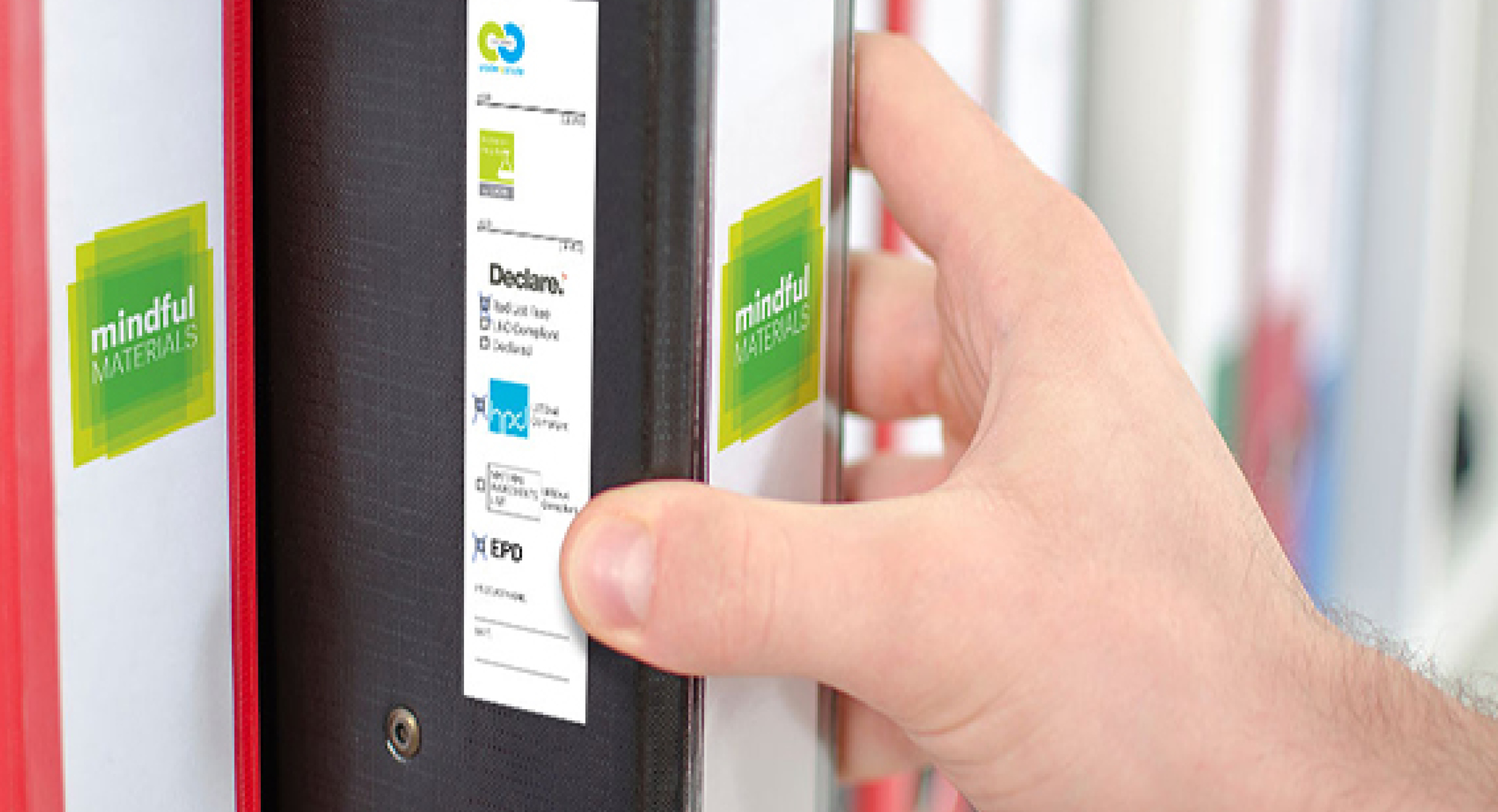
HKS Launches mindful MATERIALS: New Tool Helps Designers Make Healthy Choices
At the Chicago Material Chemistry Workshop on March 12, sponsored by Shaw Industries and HOK, we publicly announced the HKS mindful MATERIALS library labeling initiative, introducing the logo, label and system instructions. Our label, designed as a tangible means to incorporate transparency information into designers’ everyday work process, received an enthusiastic response from the workshop attendees, which included Shaw, staff from fellow design firms and spokespersons from several building product standard organizations.
The new transparency labeling system, in the works for the last eight months, was born of necessity. We had to create a way to provide easy-to-access product ingredient information for our designers where they search for and need it most, in plain sight and within arm’s length: on the spines of product binders on our resource library shelves.
Four HKS offices – including Dallas, Detroit, Chicago and Indianapolis – participated in piloting the mindful MATERIALS labeling initiative. To date, 17 manufacturers are represented and 678 products have been cataloged, resulting in 370 transparency labels adorning the product binder spines in HKS’ Dallas resource library alone.
Our challenge was to make ingredient information available to our designers quickly, simply and on a broad scale. Kirk Teske, HKS COO and chief sustainability officer, recommended that we not try to maintain the transparency information ourselves, which translates to filling our servers with umpteen folders of documents that require frequent updating – a time-intensive task.
HKS has multiple subscriptions to web-based tools that help designers locate transparency information, but there are multiple platforms, and not all products appear on one web-based tool. It’s unrealistic to expect designers to educate themselves on numerous product information websites to help guide their decisions. In the course of a typical workday, designers must search resource library shelves for product. So, that is where the transparency information should live.
Our first step was to brand the HKS library labeling initiative. Our staff knew about our building product material ingredient declaration letter, since we had already provided transparency training related to the value within HPDs (Health Product Declarations), Cradle to Cradle Product Institute certifications and EPDs (Environmental Product Declarations). The concept behind the mindful MATERIALS brand is that many factors are in play when designers select products, which traditionally have encompassed aesthetics, performance, cost and durability. The new selection paradigm also includes the products’ material ingredients and environmental impact. The planes of color in the logo, like myriad factors in building material selection, intersect to guide designers to the best material choices.
The second step was to develop our transparency label. As we began the process, we had several opportunities to interact with carpet manufacturerShaw Industries. Two key individuals, Matt van Duinen, Product Sustainability Manager, and Tim Conway, Vice President for Sustainability Account Development, provided a combination of detailed focus and broad level pragmatism that helped inform the final version of our transparency label.
The label quickly and easily communicates which product ingredients inventory and environmental impact data is available. It also sends a clear message to the manufacturers’ product reps that HKS values this information.
Without pulling a binder from a shelf, the designer can see the logo on the binder spine. The designer can then pull the binder to see the transparency label which indicates whether there’s an HPD, other material ingredient information, an EPD or a Cradle to Cradle certification, as well as the product name, recycled content and point of manufacture (POM).
In the mindful MATERIALS system, a product with no available transparency information boxes to check does not receive the logo or a transparency label. Over time, labeled products will inform library real estate. Precedence will be given only to those products that have the transparency information HKS values.
More than two years ago, via an open-industry letter, we began requesting that manufacturers disclose to us the chemical ingredients in their products. Since that time, a handful of HKS staff has worked tirelessly with manufacturers to uncover and document the transparency information they have made available.
While the label doesn’t necessarily specify an optimized product, it does point to products whose manufacturer is willing to disclose their material ingredients and/or environmental impacts. What a manufacturer discloses will be reviewed by stakeholders, sales staff and customers. We believe that disclosure and information will drive product innovation, improvement and optimization of products.
In addition to the physical labels, we maintain a materials spreadsheet on our intranet. As each manufacturer prepares to come into our offices and label their products, they complete a spreadsheet for all of their company’s products, indicating what transparency information exists for each product. All information is incorporated into the main spreadsheet. Those line items for products without transparency dates are grayed out, but still legible, and those product binders don’t receive a logo or transparency label on the spine.
We are in the process of extending this initiative beyond our Dallas headquarters and Midwest pilot program offices. A labeling champion will be identified in each office and a 20-minute training module will be shared with each studio and/or office. There is now a sense of substance to our quest for transparency – our designers are eager to share with our clients the concrete way in which materials decisions are made within our practice. The manufacturers now have a heightened awareness that we are serious about transparency. If a manufacturer doesn’t have transparency information, the local rep feels more pressure to take the message back to their technical staff. For those manufacturers who do have transparency information, they feel it’s now being recognized by HKS in a meaningful way.
Following our presentation at the Chicago Material Chemistry Workshop, Tim Conway from Shaw Industries said via e-mail, “The initiative that you have taken to deliver healthy building specifications and the commitment to follow through with a program like mindful MATERIALS shows HKS’ industry leadership. Your team has done the work to go from idea to implementation, which in my opinion, has been one of the biggest challenges that I see in this market transformation. Please keep the lines of communication open, and let us know what we can do to help. You have every resource at Shaw Industries at your disposal. I look forward to seeing what we can accomplish when we work together.”
This is a powerful testament to working together with our industry partners to create meaningful change.
We share this tool to benefit both the building product and design industries. We want to see selections informed by our mindful MATERIALS system truly transform the spaces we create. HKS is also in the process of documenting the details of this process and collaborating with a group of other architectural firms to make this tool available industry wide.
Material transparency is here to stay. Incorporating these materials selections into our daily practice is gaining traction – one labeled binder at a time.


